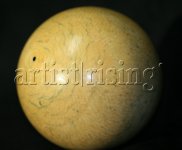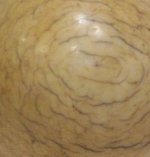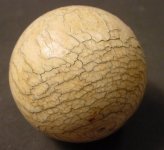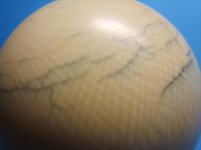I have (4) billiard balls from at least 1890 (could be older but not newer). What were they made out of then?
You are using an out of date browser. It may not display this or other websites correctly.
You should upgrade or use an alternative browser.
You should upgrade or use an alternative browser.
Old balls - Ivory
- Thread starter hdgis1
- Start date
I have (4) billiard balls from at least 1890 (could be older but not newer). What were they made out of then?
Likely ivory. There weren't many substitutes for ivory back then. A close inspection should confirm it. Look for light grains marks and shallow fractures (if it was used).
Are they carom balls or pool balls? Carom balls were mostly ivory and you should be able to see the grain without any problem, as shown in the eBay auction that I linked to above. There were also composition carom balls made about that time. A good reference for this is the book by the Stellinga's -- "Pool & Billiard Collectibles."I have (4) billiard balls from at least 1890 (could be older but not newer). What were they made out of then?
Nope that wasn't it. I saw that post but still cant find the right one. There were three cue balls right next to each other and they were pretty good close up pics. Had some reddish discoloring in each and some black spots as well.
Sorry!! the reddish discoloring was what i decribe as a dye. Those were billiard balls. A lot of the time the dye has practically worn off. The small black dots is actually the nerve from the center of the tusk!
Thanks to 8 ball Einstein and Bob Jewett (long time fan of your articles).
They are carom balls (carom is the term for a 3 cushion billiard ball right?) not pool balls.
My Great Grandfather had them and they were passed down they are never for sale and I don't understand why they were passed down because my dad who doesn't care about pool was given them by my grandfather.
I also received a few pieces of old chalk. Sounds obvious since chalk is white but it looks weird for pool chalk.
On the subject of ivory what's the safest way to clean them?
They are carom balls (carom is the term for a 3 cushion billiard ball right?) not pool balls.
My Great Grandfather had them and they were passed down they are never for sale and I don't understand why they were passed down because my dad who doesn't care about pool was given them by my grandfather.
I also received a few pieces of old chalk. Sounds obvious since chalk is white but it looks weird for pool chalk.
On the subject of ivory what's the safest way to clean them?
If they are a four-ball set and ivory and in good condition, they could be worth quite a bit, although most collectors would want the box they came in with them.Thanks to 8 ball Einstein and Bob Jewett (long time fan of your articles).
They are carom balls (carom is the term for a 3 cushion billiard ball right?) not pool balls.
My Great Grandfather had them and they were passed down they are never for sale and I don't understand why they were passed down because my dad who doesn't care about pool was given them by my grandfather.
I also received a few pieces of old chalk. Sounds obvious since chalk is white but it looks weird for pool chalk.
On the subject of ivory what's the safest way to clean them?
I've heard of using rubbing compound to clean up dirty ivory balls, but I'd be afraid of getting the compound into the cracks. Maybe very fine sand paper, like #2400?
But some collectors would rather have the balls in as-found condition, so if you want to sell them it's better not to try to clean them.
Some chalk goes for hundreds of dollars a piece. Are there any labels left?
PM sent thanks for the help
None of those balls including the cue is ivory! I currently have over 500 ivory balls in my collection and that cue is DEFINITELY NOT IVORY! Ivory has a very unique crazing,cracking pattern that is very easy to spot. Ivory even when not cracked has a grain pattern to it.
You sure have a lot of balls.
ill upload a picture tonight i made of my oldest carom ivory ball set (around 1850). This ball was so old, you could perfectly see the typical ivory cross pattern in it. I made a closeup.
how to recognise:
- 2 black dots on either side of the ball. the nerve from the tusk going from one side to the other side.
- a cross pattern grain in the older ivory. It kinda looks like a hologram or 3d and depends alot on the lightning.
- cracks, circular crakcs that have the nerve of the tusk as a center. Its much like a tree. usually you have a crackfree surface at the outer edge (1 layer) , then several circular cracks (from in between the layers) from the outside to the center,and usually less cracks around the center, the hardest part of the ivory.
i really need to upload this picture. This grain was so intense, i doubt you can find a much better picture of that typical ivory grain. IF ivory is used on a cue, the grain should be the one thing that will tell you if its ivory or not.
how to recognise:
- 2 black dots on either side of the ball. the nerve from the tusk going from one side to the other side.
- a cross pattern grain in the older ivory. It kinda looks like a hologram or 3d and depends alot on the lightning.
- cracks, circular crakcs that have the nerve of the tusk as a center. Its much like a tree. usually you have a crackfree surface at the outer edge (1 layer) , then several circular cracks (from in between the layers) from the outside to the center,and usually less cracks around the center, the hardest part of the ivory.
i really need to upload this picture. This grain was so intense, i doubt you can find a much better picture of that typical ivory grain. IF ivory is used on a cue, the grain should be the one thing that will tell you if its ivory or not.
Thanks for the research.Not pool science to find pics...
The first pic is of a "black" or "spotted" carom ball. It has a black dot inserted at the location of the "nerve canal" which is the center of the tusk. The small closeup shows what the nerve canal looks like if unfilled.
These days a solid yellow (plastic) ball is used as the "black" or "spotted" ball.
Not pool science to find pics...
:grin: the last ball has a really beautifull crack patern.
here is a picture of the ball i ment. Mainly i love this ball because of the 3d hologram looking cross pattern of the grain of ivory that is so clearly visible.




